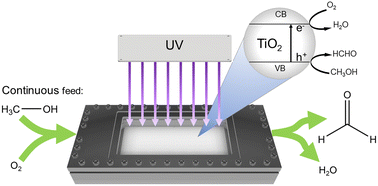Photocatalytic methanol oxidation to formaldehyde in a continuous laboratory plant over Aeroxide P25†
Abstract
We here report the photochemical synthesis of formaldehyde by gas phase methanol oxidation with oxygen in a sophisticated continuous laboratory setup. The commonly used benchmark photocatalyst Evonik Aeroxide P25 was applied in combination with a narrow peak UV-A LED light source. Prior to its use, the applied powder catalyst was immobilized with a simple spray coating technique to a steel plate support (300 mm × 130 mm × 20 mm). With this system, reaction engineering studies have been carried out to elaborate the dependencies of catalyst mass, irradiation, residence time and temperature on achieved conversions, selectivities, yields, reaction rates, and apparent quantum efficiencies. We found that catalyst load influences conversion in an extended plateau like manner. High irradiation and residence time benefit MeOH conversion while the selectivity for HCHO decreases with both parameters. Temperature showed an interesting influence, as it increases both conversion and selectivity, until desorption effects become dominating over 120 °C. Our work thus for the first time provides application relevant information for an industrial highly interesting reaction and a heavily researched model photocatalytic system that has so far been mainly studied under surface science conditions.



 Please wait while we load your content...
Please wait while we load your content...